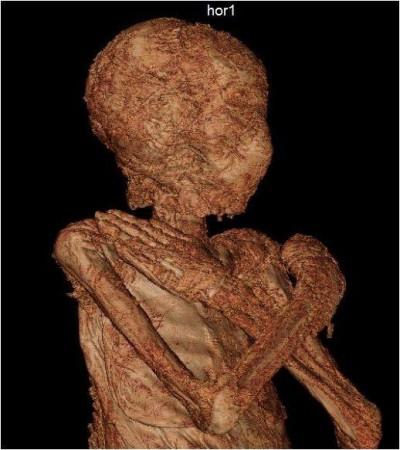In a discovery that makes the idea of secret within a secret quite literal, Polish scientists have discovered the world's first pregnant mummy from ancient Egypt. The mummy which was until recently believed to be a man was found to have a 7 to 8 months old foetus in its womb.
According to the researchers from the Warsaw Mummy Project, a 'tiny foot' was spotted in the womb of the 2,000-year-old mummy while radiological examinations on it. Interestingly, the preserved remains were believed to be that of an Egyptian priest called Hor-Djehuty (who lived in 1 BC) for several years and was housed at the National Museum in Warsaw.

"For unknown reasons, the foetus had not been removed from the abdomen during the mummification. For this reason, the mummy is really unique. Our mummy is the only one identified so far in the world with a foetus in the womb," said Dr. Wojciech Ejsmond, corresponding author, in a statement.
Changing Identities
While the mummy is now confirmed to be that of a childbearing woman, her identity has undergone interesting changes for over nearly 200 years. In 1826, the sarcophagus containing the embalmed body was donated to the University of Warsaw. Since 1917, it has been kept at the National Museum.

Initially, the remains were believed to be that of a woman due to the ornate nature of the coffin. However, after the inscriptions on it were translated in around 1920, 'she' became a man. "Scribe, priest of Horus-Thoth worshipped as a visiting deity in the Mount of Djeme, royal governor of the town of Petmiten, Hor-Djehuty, justified by voice, son of Padiamonemipet and lady of a house Tanetmin," said the translation.

Thanks to modern technology, the misidentification was finally corrected in 2016 by the same team involved in the current study. They learnt that the mummy was that of a woman, probably between 20-30 years of age, using computer tomography; thereby, eliminating the need to unwrap the 2-millennia-old bandages.
A Woman from A High Place
One of the first clues indicating her gender was her delicate skeletal structure. "This was the first hint that we were not dealing with the person identified in the inscription on the coffin, in which the body had been placed," remarked Dr. Marzena Ożarek-Szilke, lead author of the study

As more detailed anthropological examination followed, the lack of a penis in the mummy convinced the researchers that the body contained within the bandages was indeed that of a woman. A 3D visualization of the remains revealed long, curly hair and mummified breasts.
While the analysis confirmed the mummy's gender, the manner in which it was prepared suggested that she was a woman of high social position. She had been meticulously mummified, wrapped in fine fabrics, and laid to rest with an exquisite set of amulets.
First Pregnant Mummy from Ancient Egypt

During the comprehensive analysis of X-rays and images from tomographs, the team ended up spotting an entire foetus. Their examination revealed that the unborn child was around 26-28 weeks old.
"We were already at the stage of summarizing the project and sending the publication to print. With my husband Stanisław, an archaeologist of Egypt, we had the last look at the images and noticed a familiar image for parents of three children (themselves) in the deceased woman's abdomen, a tiny foot," said Dr. Ożarek-Szilke.

The authors are yet to identify the gender of the baby and the reason behind the non-removal of the foetus from the womb. However, the team intends to ascertain the cause of the mystery woman's death through the analysis of trace quantities of blood preserved in the soft tissues of the deceased
"High mortality during pregnancy and childbirth in those times is not a secret. Therefore, we believe that pregnancy could somehow contribute to the death of the young woman," concluded Dr. Ejsmond.












